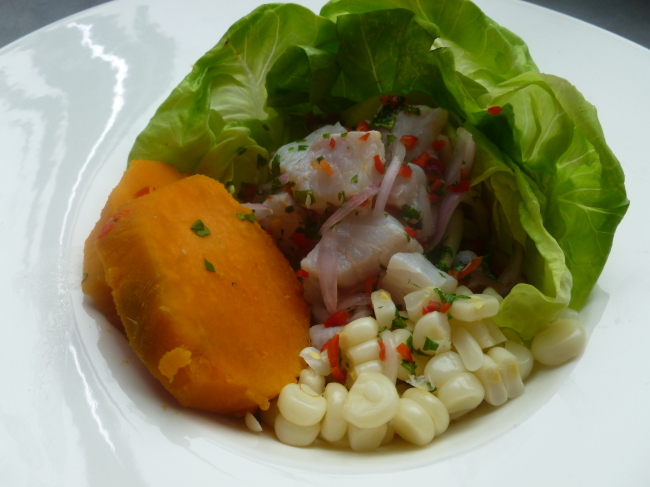In recent years, Peruvian cuisine has become recognized worldwide and the highlight of a series of articles and reports published by prestigious news sources around the world.
In its article “Food of the Andes by the Golden Gate,” the New York Times said that Peru’s culinary profile was rising due to its diverse climate and ecology that produces a wide variety of food. Peruvian cooking has been influenced by Andean, Spanish, Chinese, Japanese and African cultures, and has 468 different dishes, the largest number in the world according to The Guinness Book of World Records.
The South American country’s mouthwatering cured-fish ceviches, spicy mashed-potato causas and tender alpaca steaks are making Peru a world culinary star. International gastronomes such as Denmark’s Ren Redzepi and Spain’s Ferran Adri sing the praises of Peruvian food, and Peruvian restaurants are springing up across the Americas, Spain and London.
In its article “Food of the Andes by the Golden Gate,” the New York Times said that Peru’s culinary profile was rising due to its diverse climate and ecology that produces a wide variety of food. Peruvian cooking has been influenced by Andean, Spanish, Chinese, Japanese and African cultures, and has 468 different dishes, the largest number in the world according to The Guinness Book of World Records.
The South American country’s mouthwatering cured-fish ceviches, spicy mashed-potato causas and tender alpaca steaks are making Peru a world culinary star. International gastronomes such as Denmark’s Ren Redzepi and Spain’s Ferran Adri sing the praises of Peruvian food, and Peruvian restaurants are springing up across the Americas, Spain and London.

Lima, home to about 8 million of Peru’s 30 million people, is an architectural as well as ethnic, economic and culinary jumble. The central square of Plaza de Armas looks like Cadiz; the glassy, high-rise coastline looks like Malibu; the mountainside resembles Cape Town. Downtown Barranco recalls Havana, inland Miraflores, Detroit. The auto district of Miraflores used to be poor, dangerous and unsavory. Now, the garages that keep Lima’s millions of cars running are interspersed with chic eateries.
Disparate topography has provided Peruvian cooks with an unrivalled natural pantry, including the tropical rainforest, the altiplano, and some of the world’s most plentiful and diverse fish.
Traditionally, Peruvian cooking was enjoyed at home, while fancy restaurants offered foreign food. The change since the turn of the millennium has been breathtaking. Peruvians of all classes now take huge pride in their cuisine, while young people flock to study at a growing number of culinary schools.
The Embassy of Peru has organized a weeklong Peruvian food festival to kick off July 29 at Grand Hyatt Seoul.
Such dishes to be served will include quinoa, a fantastic, healthy food eaten for thousands of years in the Andes mountains in South America. It was a very important part of the Incan diet, and is still sometimes referred to as “the gold of the Incas.”
Quinoa is often thought of as a grain, but it’s actually the seed of a leafy green plant called Chenopodium, which is related to spinach and swiss chard and has a structure similar to wheat or rice. It is a complex carbohydrate that digests slowly and will not cause blood sugar levels and insulin levels to spike.
It’s also an excellent source of energy. One cup of cooked quinoa contains 5 grams of fiber. Quinoa is higher in calcium, B vitamins, vitamin E, phosphorus, magnesium, potassium, iron, copper, manganese and zinc than most grains.
The United Nations General Assembly declared 2013 as the “International Year of Quinoa” in recognition of ancestral practices of the Andean people, who have preserved quinoa as food for present and future generations, through knowledge and practices of living in harmony with nature.
The wife of Peru’s President Ollanta Humala, Nadine Heredia, was appointed a U.N. FAO special ambassador for the International Year of Quinoa.
-
Articles by Korea Herald



![[Exclusive] Korean military set to ban iPhones over 'security' concerns](http://res.heraldm.com/phpwas/restmb_idxmake.php?idx=644&simg=/content/image/2024/04/23/20240423050599_0.jpg&u=20240423183955)

![[Graphic News] 77% of young Koreans still financially dependent](http://res.heraldm.com/phpwas/restmb_idxmake.php?idx=644&simg=/content/image/2024/04/22/20240422050762_0.gif&u=)



![[Pressure points] Leggings in public: Fashion statement or social faux pas?](http://res.heraldm.com/phpwas/restmb_idxmake.php?idx=644&simg=/content/image/2024/04/23/20240423050669_0.jpg&u=)










